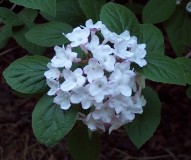Here’s one of my favorite spring-flowering shrubs: Viburnum carlesi, Korean Spice Viburnum. I planted three along the side of my deck a couple of years ago, and every spring since, I’ve been glad I did. Their flowers are wonderfully fragrant — as my daughter said this morning, “that must be what heaven smells like.” And the scent carries. I can smell them everywhere in my yard, and even throughout the house on a warm afternoon when the windows are open.

Mine is the compact form so it will only grow to three feet or so. There are other cultivars that will grow to about five feet.
Long before I’d stumbled across my first cultivated Viburnum (in a municipal planting in downtown Rochester, in the evening after work — the lot is now a parking garage) I was familiar with a number of wild species. According to Wikipedia, there are about 175 different shrubs in the Viburnum genus. You may have seen the wild ones, too. They tend to grow in clumps along the margins of forests and fields and bloom with white clusters of flowers. In late summer the bushes are covered with berry-sized clusters of fruit, often blue-black, each with a single flat seed inside. The birds love the fruit, and many are edible for us, too, although they aren’t particularly fleshy or flavorful. Some of the bushes are quite tall, 15 feet or more, and their clumping habit means their canopies form wonderful grott0-like hiding places, perfect for playing when you’re a kid growing up in the country.
My dad once mentioned that his aunt (is that right, Dad?) used to make a jelly from highbush cranberry, one of the wild Viburnums, so I tried it too about 15 years ago. It was an interesting jelly, tart and with a musky, earthy flavor that reminded me of tomato. Kind of. (Here’s a photo of a highbush cranberry bush with fruit. It’s easy to spot since the fruits are a brilliant red.)
Here in New York State, several species of our native Viburnums are sold as ornamentals, but unfortunately some of them are vulnerable to damage (sometimes extensive) by the Viburnum leaf beetle, a pest introduced from Europe. Sigh. Highbush cranberry is one of the species that gets hit the hardest — defoliated, sometimes twice in a year, once the beetles settle in.
I’ve seen the beetle around my neighborhood, so this year I’m going to submit my observations to Cornell to help them track the beetles’ spread. Korean Spice Viburnum isn’t vulnerable, btw. But truthfully, much as I love mine, I’d rather it were vulnerable instead of our native Viburnums. After all, ornamentals, by definition, have humans assigned to their care. Wild plants don’t.

I was surfing the net on information on viburnum carlesi and your web page came up :) I have been chasing the beautiful floral smell of this plant since I was in grade school and after ruling out honeysuckle, lavender, wildflowers, etc. I think that this might be what I am looking for. I am in Southeast Michigan and I can’t seem to find this particular variety anywhere (for sale at least) but I think it grows wild everywhere. Do you have any information on how I could obtain seeds for this wonderful plant so I too may enjoy this wonderful fragrance? Any help would be greatly appreciated!:)
Hi, Paul, I don’t know about seeds — perhaps mine are hybrids as I don’t see any seeds on my plants — but you can buy shrubs at Bluestone Perennial for under $8 apiece.
http://www.bluestoneperennials.com/b/bp/VICCP.html?from_search=1&mv_tmp_session=1&mv_session_id=nsession
I should add, that’s the compact form which is the same one I’m growing. There are larger forms — some of my neighbors have them — they get quite big, to 7, 8 feet high.